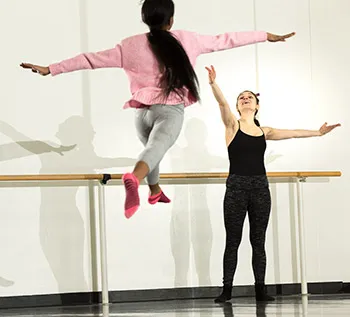Dance Flowers

Amelia Estrada ’17 uses dance as a tool for empowerment as she works with students from Chester. “You can help young people discover a way to be active, to be physically creative and also learn the discipline that comes from dance and apply that to other areas of their lives,” she says.
Since 2001, Swarthmore's Lang Center for Civic and Social Responsibility has built on the pioneering vision of philanthropist Eugene M. Lang '38, H'81. The singular goal of this son of Hungarian immigrants was to enhance the connections among coursework, fieldwork, and citizenship. His commitment to growing a more just and beautiful world continues to be cultivated — and then some.
Early on a January Saturday, a light snow fell outside the Lang Performing Arts Center. For the most part, the campus was still. But inside the dance studio, Amelia Estrada ’17 was already in a full sweat, charging across the smooth floor demonstrating athletic leaps and scissorlike steps to her young dance troupe. In an unintended tribute to Degas, the clutch of 10-year-olds observed her in varying states of concentration. One looped herself across the long wooden bar; another gazed at her reflection in the wall of mirrors, lost in thought.
“Step, kick—I want to see straight legs,” Estrada called out cheerily. “Try your best. Clean, straight lines. Nice!”
Wearing T-shirts emblazened with slogans like Born2Shine and Stargazer, the girls raced to fashion their movements after Estrada’s, reflecting her distilled energy.
Since September, Estrada, an honors dance and classics major, has been leading the students every weekend under the guidance of Sharon Friedler, professor emerita of dance. The 16 girls, all members of Chester Children’s Chorus, are learning a Horton-based modern dance curriculum. The class is the core of Estrada’s honors thesis and brings to life her belief that dance—and the arts in general—can transform disenfranchised communities.

“The act of dancing,” says Pallabi Chakravorty, associate professor and director of the dance program, “allows us to collectively imagine and then take action for a better future.”
Friedler agrees, and the retired professor so believed in Estrada that she returned to guide the student through her thesis. The two planned the dance course curriculum for eight months on a grant from the Lang Center’s Swarthmore Fund. In fact, Friedler’s outstanding career inspired the Lang Center to establish Arts and Social Action, which Chakravorty now heads, as one of four faculty-led initiatives that empower professors to innovate and collaborate in their areas of expertise—including on projects like Estrada’s.
“Amelia’s work is important for a thousand reasons,” Friedler says. “As a young woman of color, she wants to empower her students through dance. When challenges happen in their lives, they can be heard, and work through them, via the discipline of the arts.”
Growing up in Boxborough, Mass., Estrada was one of the only Latina students in her mostly white suburban community, which heightened her awareness of race and class. Adding to her worldview was a diagnosis of dyslexia that prevented her from being able to read until third grade.
“My dyslexia is part of the reason I am creative,” says Estrada, whose parents eventually advocated for a move to a different school where she bloomed. “Dance as a release is a wonderful tool that makes me feel vulnerable and open in a positive way as opposed to being graded or judged. My students have the ability to transfer that energy.”
As the Saturday class ended, Estrada called the young dancers to the center of the room. They joined hands in a circle, thanking each other for participating. To close the session, they began singing a well-rehearsed piece from the Children’s Chorus, their voices tied in ethereal harmony. Then, in a blur, they were through the door and out into the world.
Read about more Lang Center for Civic & Social Responsibility initiatives and programs in The Bulletin.
Learn about Swarthmore’s impact on the local and global community at lifechanging.swarthmore.edu.



